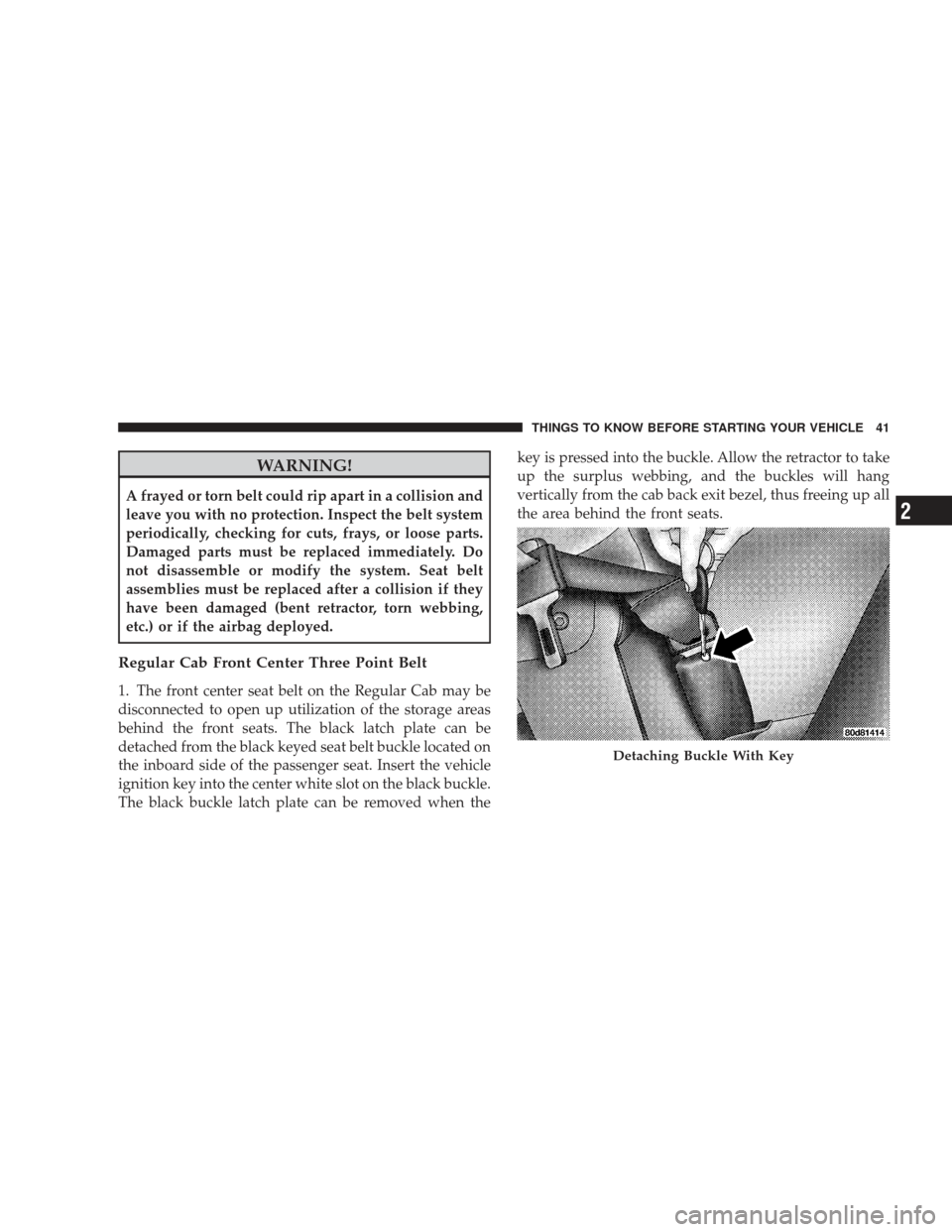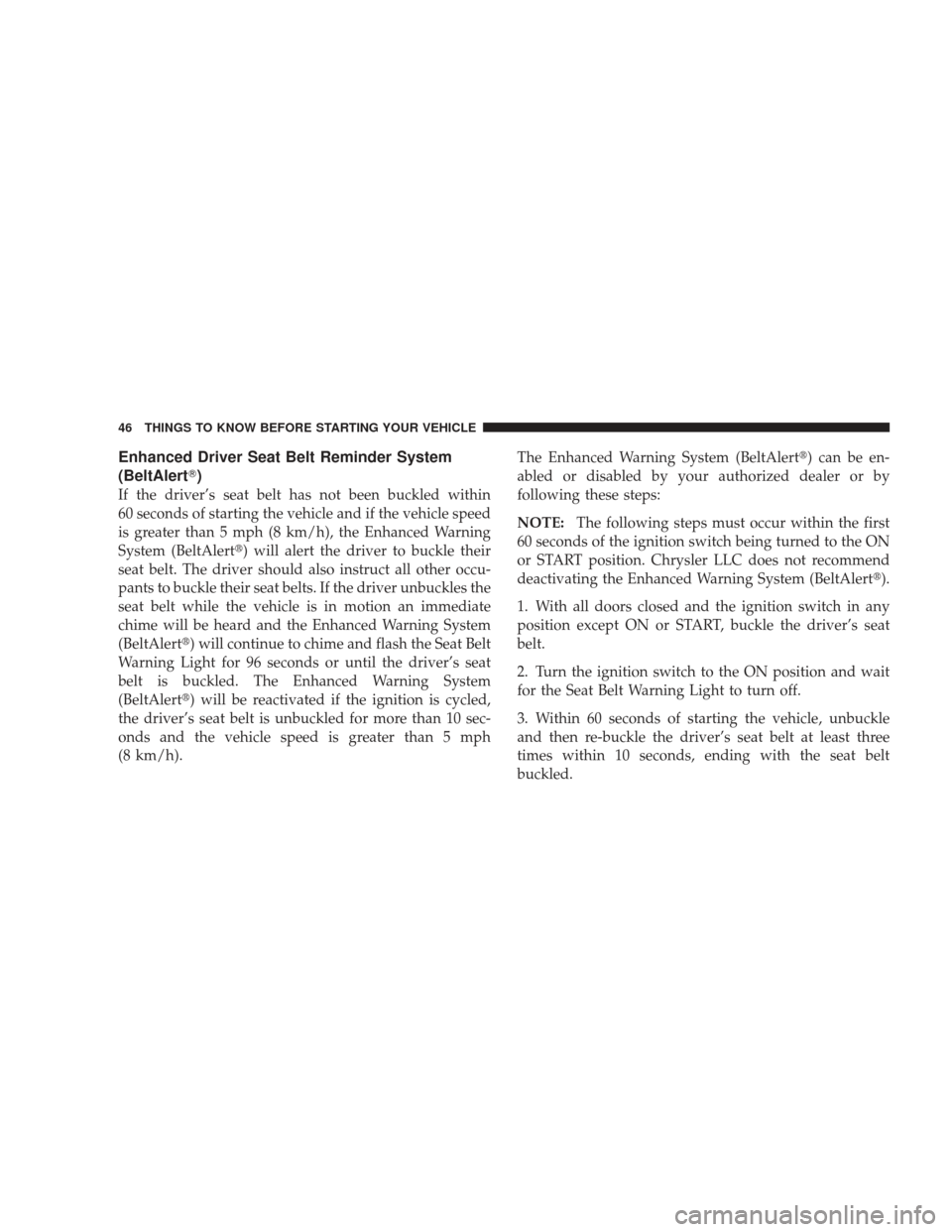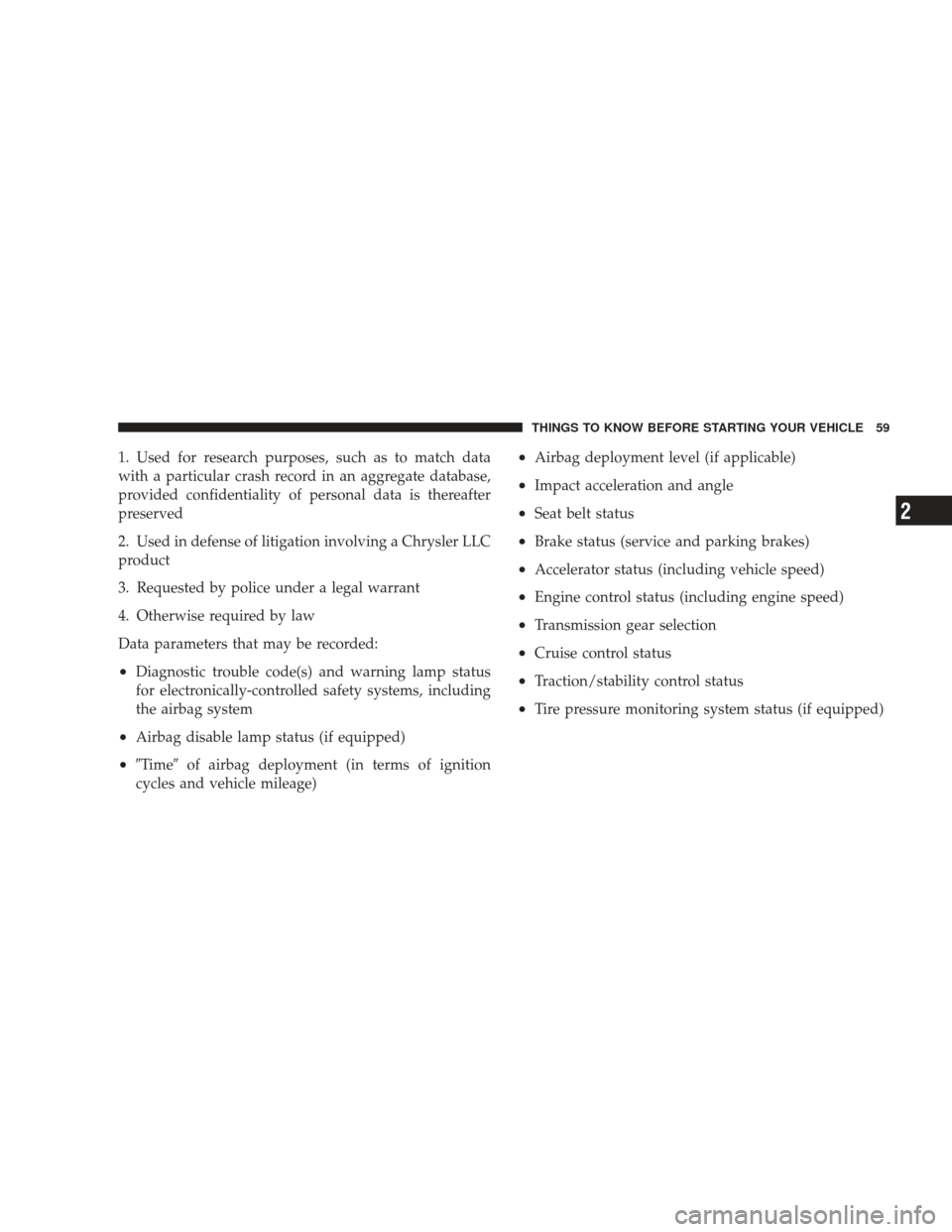Page 34 of 429
WINDOWS
Power Windows – If Equipped
The control on the left front door panel has up-down
switches that give you fingertip control of all power
windows. There is a single opening and closing switch on
the front passenger door for passenger window controland on the rear doors of Quad Cab�
models. The
windows will operate when the ignition switch is turned
to the ON or ACC (Accessory) position and for ten
minutes after the ignition is turned OFF or a front door is
opened.
NOTE: The Power Accessory Delay feature will allow
the power windows to operate for 10 minutes after the
ignition is turned OFF.
WARNING!
Never leave children alone in a vehicle. Leaving
unattended children in a vehicle is dangerous for a
number of reasons. A child or others could be seri-
ously or fatally injured. Don’t leave the key in the
ignition. A child could operate power windows,
other controls, or move the vehicle.
Power Window Switches
32 THINGS TO KNOW BEFORE STARTING YOUR VEHICLE
Page 43 of 429

WARNING!
A frayed or torn belt could rip apart in a collision and
leave you with no protection. Inspect the belt system
periodically, checking for cuts, frays, or loose parts.
Damaged parts must be replaced immediately. Do
not disassemble or modify the system. Seat belt
assemblies must be replaced after a collision if they
have been damaged (bent retractor, torn webbing,
etc.) or if the airbag deployed.
Regular Cab Front Center Three Point Belt
1. The front center seat belt on the Regular Cab may be
disconnected to open up utilization of the storage areas
behind the front seats. The black latch plate can be
detached from the black keyed seat belt buckle located on
the inboard side of the passenger seat. Insert the vehicle
ignition key into the center white slot on the black buckle.
The black buckle latch plate can be removed when thekey is pressed into the buckle. Allow the retractor to take
up the surplus webbing, and the buckles will hang
vertically from the cab back exit bezel, thus freeing up all
the area behind the front seats.
Detaching Buckle With Key
THINGS TO KNOW BEFORE STARTING YOUR VEHICLE 41
2
Page 48 of 429

Enhanced Driver Seat Belt Reminder System
(BeltAlert�)
If the driver’s seat belt has not been buckled within
60 seconds of starting the vehicle and if the vehicle speed
is greater than 5 mph (8 km/h), the Enhanced Warning
System (BeltAlert�) will alert the driver to buckle their
seat belt. The driver should also instruct all other occu-
pants to buckle their seat belts. If the driver unbuckles the
seat belt while the vehicle is in motion an immediate
chime will be heard and the Enhanced Warning System
(BeltAlert�) will continue to chime and flash the Seat Belt
Warning Light for 96 seconds or until the driver’s seat
belt is buckled. The Enhanced Warning System
(BeltAlert�) will be reactivated if the ignition is cycled,
the driver’s seat belt is unbuckled for more than 10 sec-
onds and the vehicle speed is greater than 5 mph
(8 km/h). The Enhanced Warning System (BeltAlert
�) can be en-
abled or disabled by your authorized dealer or by
following these steps:
NOTE: The following steps must occur within the first
60 seconds of the ignition switch being turned to the ON
or START position. Chrysler LLC does not recommend
deactivating the Enhanced Warning System (BeltAlert �).
1. With all doors closed and the ignition switch in any
position except ON or START, buckle the driver’s seat
belt.
2. Turn the ignition switch to the ON position and wait
for the Seat Belt Warning Light to turn off.
3. Within 60 seconds of starting the vehicle, unbuckle
and then re-buckle the driver’s seat belt at least three
times within 10 seconds, ending with the seat belt
buckled.
46 THINGS TO KNOW BEFORE STARTING YOUR VEHICLE
Page 53 of 429

Airbag System Components
The airbag system consists of the following:
•Occupant Restraint Controller (ORC)
•AIRBAG Readiness Light
•Driver Airbag
•Passenger Airbag (if equipped)
•Steering Wheel and Column
•Instrument Panel
•Crash Sensor
•Interconnecting Wiring
•Knee Impact Bolsters
•Passenger’s Side Front Airbag ON/OFF Switch (Regu-
lar Cab Vehicles Only ) (if equipped)
How The Airbag System Works
•
The Occupant Restraint Controller (ORC) determines
if a frontal collision is severe enough to require the
airbags to inflate.
•The ORC will not detect rollover, or rear collisions.
•The ORC also monitors the readiness of the electronic
parts of the system whenever the ignition switch is in
the START or RUN positions. These include all of the
items listed above except the knee bolsters, the instru-
ment panel, and the steering wheel and column. If the
key is in the OFF position, in the ACC position, or not
in the ignition, the airbags are not on and will not
inflate.
•The ORC also turns on the Airbag Warning Light in
the instrument panel for 6 to 8 seconds when the
ignition is first turned on, and then turns the light off.
THINGS TO KNOW BEFORE STARTING YOUR VEHICLE 51
2
Page 56 of 429

WARNING!
Whenever an airbag is turned off, even a lap/
shoulder belted passenger may hit their head, neck,
or chest on the dashboard (instrument panel) or
windshield in a crash. This may result in serious
injury or death.
To Shut Off the Passenger Airbag (Regular Cab Ve-
hicles Only) – If Equipped
Place the ignition key in the Passenger Airbag On/Off
Switch (if equipped), push the key in and turn clockwise,
and remove the key from the switch. This will shut off the
passenger airbag (if equipped). The OFF light near the
switch will illuminate when the ignition switch is turned
to the ON position. To Turn On the Passenger Airbag (Regular Cab Vehicles
Only) – If Equipped
Place the ignition key in the Passenger Airbag On/Off
Switch (If Equipped), push the key in and turn counter-
clockwise, and remove the key from the switch. This will
turn on the passenger airbag (if equipped). The OFF light
near the switch will be off when the ignition switch is
turned to the ON position.
If A Deployment Occurs
The airbag system is designed to deploy when the ORC
detects a moderate-to-severe frontal collision, and then
immediately to deflate.
NOTE:
A frontal collision that is not severe enough to
need airbag protection will not activate the system. This
does not mean something is wrong with the airbag
system.
54 THINGS TO KNOW BEFORE STARTING YOUR VEHICLE
Page 58 of 429

Enhanced Accident Response System
If the airbags deploy after an impact and the electrical
system remains functional, vehicles equipped with
power door locks will unlock automatically. In addition,
approximately 10 seconds after the vehicle has stopped
moving, the interior lights will light until the ignition
switch is turned off.
Maintaining Your Airbag Systems
WARNING!
•Modifications to any part of the airbag system
could cause it to fail when you need it. You could
be injured because the airbags are not there to
protect you. Do not modify the components or
wiring, including adding any kind of badges or
stickers to the steering wheel hub trim cover or the
upper right side of the instrument panel. Do not
modify the front bumper, vehicle body structure,
or frame.
•You need proper knee impact protection in a
collision. Do not mount or locate any aftermarket
equipment on or behind the knee bolster.
•It is dangerous to try to repair any part of the
airbag system yourself. Be sure to tell anyone who
works on your vehicle that it has airbags.
56 THINGS TO KNOW BEFORE STARTING YOUR VEHICLE
Page 59 of 429

NOTE:Perchlorate Material – special handling may apply:
Refer to www.dtsc.ca.gov/hazardouswaste/perchlorate.
Airbag Warning Light
You will want to have the airbags ready to
inflate for your protection in an impact. While
the airbag system is designed to be mainte-
nance free, if any of the following occurs, have
an authorized dealer service the system promptly:
•The Airbag Warning Light does not come on or flickers
during the six to eight seconds when the ignition
switch is first turned ON.
•The light remains on or flickers after the six to eight
second interval.
•The light flickers or comes on and remains on while
driving. NOTE:
If the speedometer, tachometer or any engine
related gauges are not working, the ORC may also be
disabled. The airbags may not be ready to inflate for your
protection. Promptly check the fuse block for blown
fuses. For proper location of airbag fuses, refer to “Fuses
(Integrated Power Module)” in Section 7. See your au-
thorized dealer if the fuse is good.
Event Data Recorder (EDR)
In the event of an accident, your vehicle is designed to
record up to approximately five seconds of specific
vehicle data parameters (see the following list) in an
event data recorder prior to the moment of airbag de-
ployment, or near deployment, and up to a quarter-
second of high-speed deceleration data during and/or
after airbag deployment. EDR data are ONLY recorded if
an airbag deploys, or nearly deploys, and are otherwise
unavailable.
THINGS TO KNOW BEFORE STARTING YOUR VEHICLE 57
2
Page 61 of 429

1. Used for research purposes, such as to match data
with a particular crash record in an aggregate database,
provided confidentiality of personal data is thereafter
preserved
2. Used in defense of litigation involving a Chrysler LLC
product
3. Requested by police under a legal warrant
4. Otherwise required by law
Data parameters that may be recorded:
•Diagnostic trouble code(s) and warning lamp status
for electronically-controlled safety systems, including
the airbag system
•Airbag disable lamp status (if equipped)
•�Time�of airbag deployment (in terms of ignition
cycles and vehicle mileage)
•Airbag deployment level (if applicable)
•Impact acceleration and angle
•Seat belt status
•Brake status (service and parking brakes)
•Accelerator status (including vehicle speed)
•Engine control status (including engine speed)
•Transmission gear selection
•Cruise control status
•Traction/stability control status
•Tire pressure monitoring system status (if equipped)
THINGS TO KNOW BEFORE STARTING YOUR VEHICLE 59
2